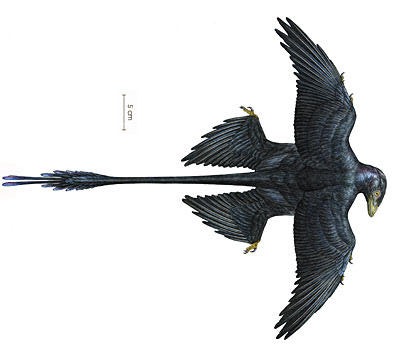
Microraptor gui holotype fossil with white arrows pointing out feather impressions, click image for background info. New colored reconstruction below the fold
Fossils are rare, fossils which preserve feathers and other soft tissue are extraordinarily rare. But scientists re-examining a fossil of a feathered, flying dinosaur unearthed in China’s rich Yixian and Jiufotang formations have found a specimen so well preserved, despite spending more than 130 million years in the ground, that they are able to determine the actual color and tone of the little dino:
(CSM) — From their analysis of modern birds, the researchers figured that this Microraptor fossil had black feathers. Furthermore, the narrow stacking of the melanosomes would have given the feathers iridescence. The researchers couldn’t be sure of the color of the sheen, or the effect of the iridescence on the feather color, because those factors depend on the thickness of the feather’s keratin coat.
Up to now paleowildlife artists and FX wizards had to rely on their imaginations and not much else. That approach led to some beautiful work like this video below courtesy of the BBC.
But this new study is strong evidence for an arguably more sensible arrangement: shiny, perhaps almost sparkling black feathers on top, maybe over a lighter underside — although the article does not that. That makes more sense to me than the multihued video version. There are M. gui fossils so well preserved that stomach content analysis has been performed indicating the little raptor preyed at least in part on small tree-dwelling lizards and mammals, almost certainly including nocturnal or crepascular feeders, which might help explain the selective advantage of dark outer feathers.
This same study found the tail feathers, the tufts on the end of a sort of boom that stuck out behind it about as long as its main body, may have held an interesting surprise; a flash of color that could have served as a mating or dominance display. So, without further adieu, microraptor, or at least one subspecies examined closely so far, may have actually looked something like this:



Without further ado (as in Much Ado About Nothing).
BTW guys I’m still moving stuff around and adding to this post. That’s generally a no-no in some new media venues, but those are mostly ones the with holdovers from trad med where it wasn’t possible to change text after publishing a run.
Wow, what a pretty bird. Maybe we should try creating these, instead of a T-Rex from a chicken. I know I wouldn’t mind seeing one fly past my window.
I can’t tell from the photos — did this critter have teeth, or just a beak like modern birds?
Looks like Toothless from How to Train Your Dragon. Nice.
M. gui, at least some of them anyway, had long, sharp serrated teeth like many of its larger, earth-bound raptor cousins. It probably could have delivered a nasty bite for a relatively small animal.
Great article, fascinating creature, superb science. Thankyou. :-)
very cool.
(wonder if it tastes like chicken?)